If you’re looking to jump into the hobby of fish keeping you couldn’t pick a better starter species than the goldfish! These diverse fish come in a rainbow of colors and fancy goldfish have other interesting traits. Did you know that the ideal goldfish temperature can range from 60 to 80°F depending on the type you’re keeping?
Here’s everything you need to know about goldfish care, including the basics of their biology, natural history and setting up the best tank for hearty and fancy types of fish!
Introduction To Goldfish
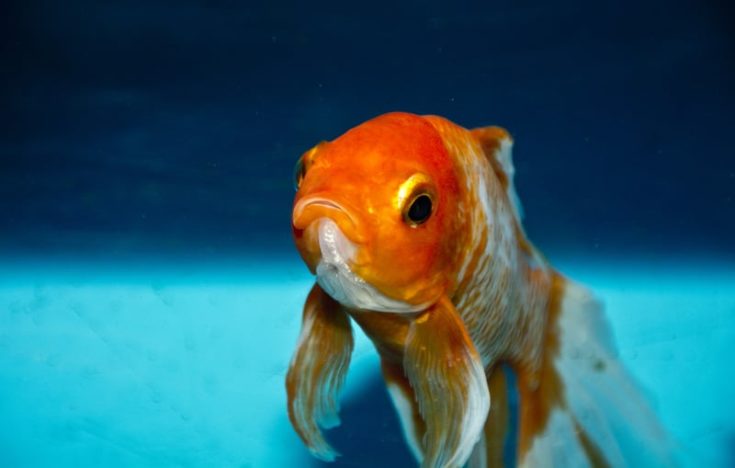
Shopping for pet fish as a child, I had no interest in the aquarium’s filled with the odd-looking, googly-eyed goldfish. Instead, I was drawn to the bright tanks of cheap feeder goldfish and their endless mix of colors and patterns.
Luckily I’ve learned a lot more about this species as I’ve matured and have long ditched my objections to the fancy goldfish types. Whether you prefer a hearty variety of goldfish for your pond or a group of fancies for an indoor aquarium, there’s a lot more to these fish than just their bright colors.
Goldfish Natural Habitat And History
Goldfish are native to China and the story of their domestication is long and intriguing. The ancient Chinese were avid eaters of wild carp (the ancestors of koi, minnows, and goldfish) and they collected the plain grey/brown colored fish and raised them in natural and eventually artificially constructed ponds.
Domestication And Selective Breeding
The wild carp bred quickly and provided an easy and reliable source of food for villagers. Occasionally, they would see a fish with a unique mutation such as a spot of bright red or orange pigmentation, and they would “rescue” it from the food population and keep it as a pet.
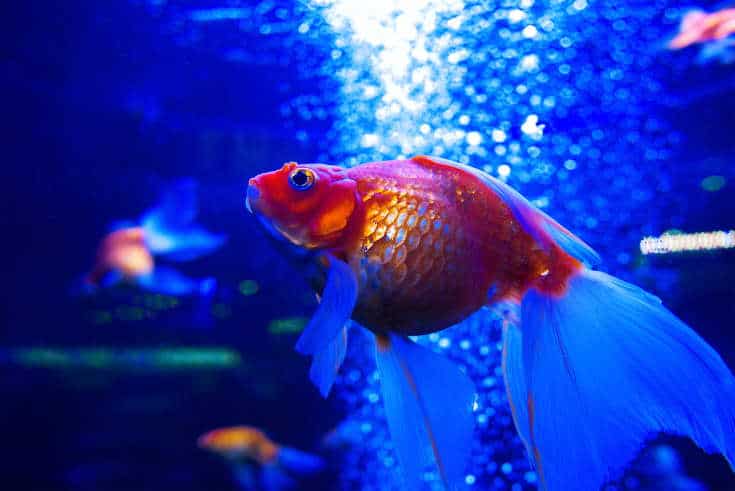
By selectively breeding these mutants for nearly 2,000 years they’ve managed to develop more than 200 distinct varieties of goldfish. The actual number is constantly changing as new crossbreeds are introduced. Many types are only found in Asia and are not likely to be available online or in an aquarium shop.
Classifying Types Of Goldfish
How many goldfish species are there in the world? You may find this surprising, but goldfish (Carassius auratus) are all considered members of a single species. US and European breeders recognize two specific varieties of goldfish while the Chinese have a more intricate system of classification. Goldfish in the West are categorized as either:
- Hearty lean-bodied goldfish with a streamlined profile and a single tail.
- Delicate fancy goldfish with egg-shaped bodies, double tails and other features unique to the specific variety.
Biology Of The Goldfish
Now that you know a little bit about their history, let’s talk about the biology of the goldfish. There are a lot of myths out there about these popular fish and that can lead to problems, like your goldfish outgrowing their habitat. Here are the facts about their growth, sensory and intellectual abilities.
Size Range Varies
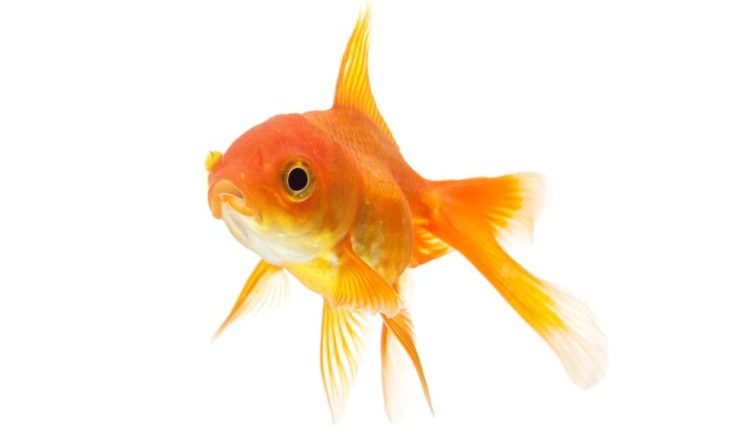
Goldfish range from about 8 to 12 inches from their snout to their tail when fully grown, although there have been reports of fish getting much larger. According to the Guinness Book of World Records, the longest goldfish measured to date was 18.7-inches long!
Fancy goldfish are usually a few inches shorter than the hearty single tail varieties, although they may be a lot taller due to their egg-shaped bodies. You may have heard the popular myth that goldfish only grow as big as the container they are kept in. Don’t believe it.
Goldfish growth is determined by genetics, water temperature and their care and diet. If you keep your fish in a tiny bowl of dirty water and feed it a substandard diet it probably won’t grow very large.
Goldfish Vision
Goldfish have been intensely studied and we know a lot about how they perceive the world. Goldfish can see the same spectrums of colors as humans, and like humans, juvenile fish develop the ability to perceive the color blue as they mature. They can distinguish between night and day and require a period of darkness to rest.
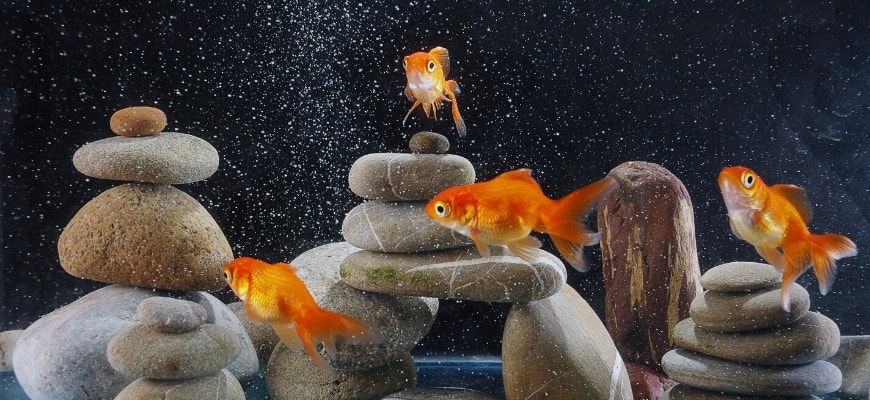
Unlike us, however, goldfish eyes have an additional type of photoreceptor that lets them see ultraviolet and infrared light. This allows them to find prey and avoid underwater predators in the wild. Adult goldfish can see clearly for about 15 feet, and you may notice your goldfish react as you approach their tank.
Hearing And Sound-sensing Abilities
Goldfish don’t have ears, but they do have two ways of perceiving sound. They have bones inside their head similar to ours that vibrate in response to sound waves moving through the water. Their brain then translates these inner ear vibrations into sounds.
They also have a lateral line of cells running down each side of their bodies. These lateral lines are sensitive to water movement. When the water around a fish moves due to a sound wave or object moving towards them, these cells detect the vibration. They can pinpoint the trajectory and identify the direction it’s coming from.
This means goldfish are very sensitive to certain types of sounds that cause their water to vibrate. Don’t bombard your goldfish tank by tapping on the glass or playing loud, thumping music near your aquarium. There are indications that goldfish can suffer hearing loss and extreme stress when exposed to excess noise.
Cognitive Abilities
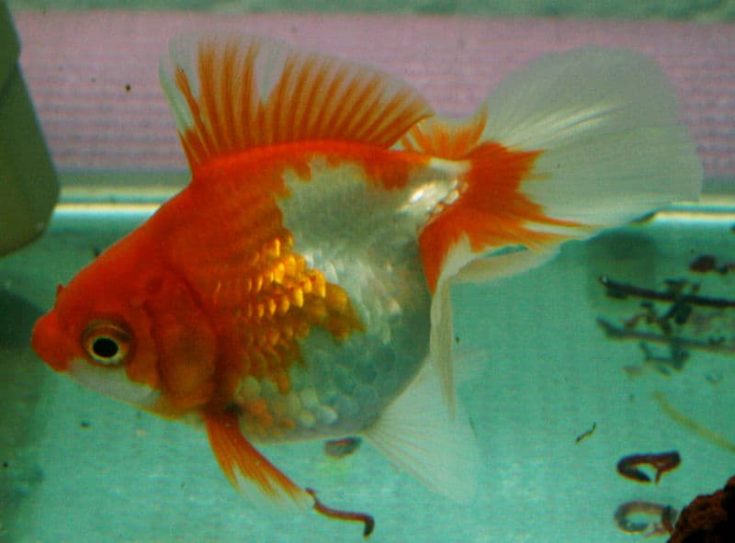
We all know the old joke that a goldfish can only remember something for about 30 seconds, but is there any truth to the tale? It always struck me as a bit suspicious, and it turns out I was right to be skeptical. Studies show that goldfish can remember things for at least 3 months and can even distinguish time intervals!
Your goldfish can’t exactly tell time, since they can’t read a clock. But if you feed and interact with your goldfish on a regular schedule they will learn to anticipate your actions. It’s actually very easy to train your goldfish to swim through hoops or dunk a miniature basketball!
Goldfish Behavior
Goldfish are friendly and social creatures and make great aquarium pets. They are not aggressive but can get nippy with each other if they are underfed, stressed or kept in tight conditions. They are curious about their environment and enjoy exploring the plants, decorations and substrate in their tank.
Keeping Groups Of Goldfish
Goldfish are best kept in pairs or groups so they have a tank mate to interact with. Avoid housing the hearty, fast-swimming varieties in the same tank as fancy goldfish. The fancies are much slower and can’t compete with them. They often starve if housed in the same tank. Can goldfish live with bettas? Find out here.
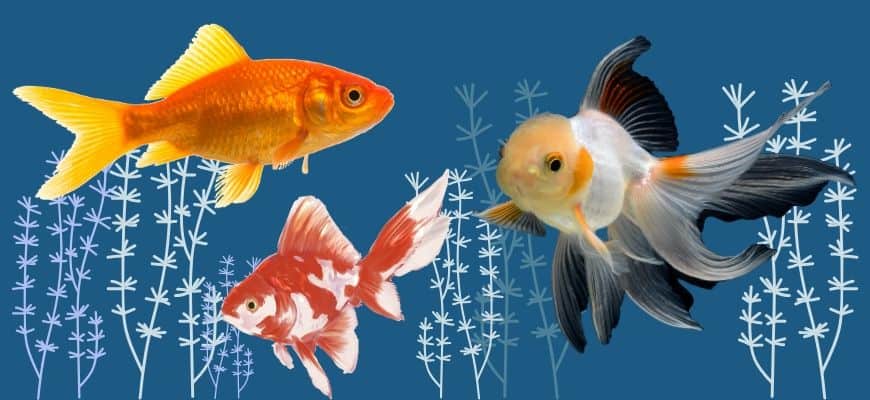
Goldfish like to school and shoal together, and during the breeding season (when their pond or tank temperature rises) the male fish may harmlessly chase the females. If you notice your fish appear stressed and chase each other outside of breeding, it could signal problems with your tank.
Goldfish Love To Eat!
Goldfish are omnivores, which means they eat plants and animal foods like eggs, insect larvae, small snails, and crustaceans. Goldfish are always on the lookout for food and test out objects by nibbling on them. They won’t stop eating as long as there is food to find, so be careful about your amounts and don’t overfeed them.
If a goldfish can fit an object in their mouth they will eat it. They pick through the substrate looking for scraps, and have been known to take bites of your plants and even uproot them for fun! Goldfish are notorious for leaving their aquariums messy, so if you like a tidy tank this may not be the species for you.
Anatomy Of Hearty And Fancy Goldfish
How can you tell what kind of goldfish you have? It’s not hard to distinguish between hearty and fancy goldfish since the tail configuration gives them away, but there’s still a lot of variation to cover. Let’s talk about the anatomy and morphology (difference in physical traits) of goldfish!
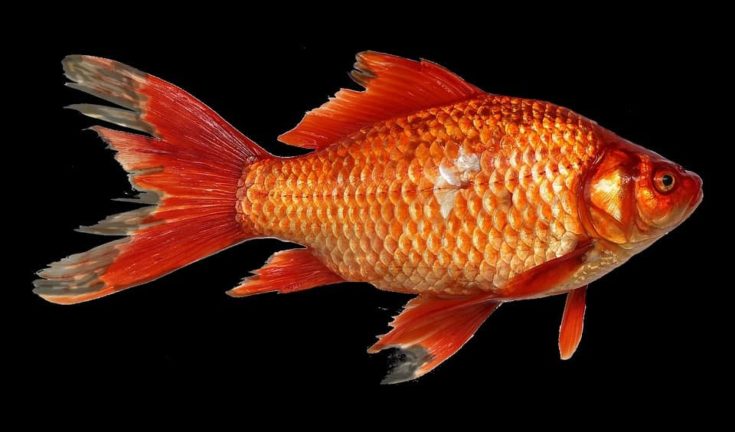
Differences Between Genders
It’s not easy to identify male and female goldfish outside of the breeding season. Juvenile goldfish of both genders appear nearly identical until they reach sexual maturity (12 months after hatching) and are ready to spawn.
- Female goldfish may have slightly deeper bodies, but this isn’t consistent across types. When they are ready to lay eggs, their vent is enlarged and turns outward, while the male’s vent remains small and turned in.
- During the spawning season, mature male goldfish develop tubercles on their gill covers and the edge of their pectoral fins. These white growths, which resemble pimples, signal the male’s readiness to fertilize eggs.
Tail Length And Shape
The primary way you can identify whether your fish is a hearty or fancy goldfish is by their tail. Hearty goldfish always have single straight tails, while the fancy fish have double tails. Both types can be long or short, but doubles may be webbed or have curly ruffled edges. Common terms for these include Fantail, Veiltail and Curly Tail.
There are also fancies with long Phoenix Tails. This describes a fish from a breed without a dorsal fin that typically has a short double tail. A Phoenix tail goldfish has a long fantail despite being from a breed that is usually short-tailed.
Body Shape
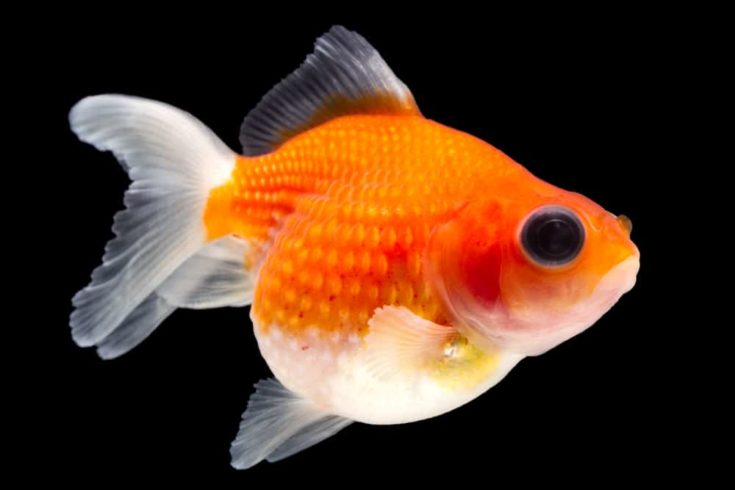
Hearty goldfish have longer, leaner bodies than the fancy goldfish. They are more streamlined, which makes them faster and more maneuverable. Fancy goldfish have squat, egg-shaped or round bodies nearly as tall as they are long. Some breeds are known for their uniquely humped conformations, like the Ryukin.
Dorsal Fin Present Or Missing
Goldfish either have a single dorsal fin or are missing the fin entirely. There are several fancy goldfish breeds that are characterized by their missing dorsal fin, and these tend to be the worst swimmers. The missing fin makes it harder for them to maintain a straight line or maneuver in the water.
Fancy dorsal-less goldfish often have other traits like upturned or bubble eyes or head growths that distinguish their specific breed. These are usually the most delicate varieties and are prone to injury or ill-health.
Head Growth Or Hood (Wen)
Several breeds like Lionheads and Orandas are known for the growth or hood that develops on their heads as the fish reaches maturity. The hood can cover most of the head and gill covers, or just appear on the top of the head. When the hood is limited to the top of the head it’s referred to as a “goose head” or “high headed” goldfish.
Telescopic Or Dragon Eyes
These fancy goldfish have eyes which protrude from their face. Telescopic goldfish are more common, while those with longer cone-shaped protuberances are often called Dragon Eyes. Black Moors are another variety of telescopic goldfish.
Bubble Eyes
Bubble-eyed goldfish have large, fluid-filled balloons of skin that protrude from underneath each eye. These delicate sacks of fluid are prone to infection and injuries from other fish and tank decor, and render these ones of the most delicate types of goldfish to keep. They may have trouble with their bubbles obscuring their vision.
Pom Poms
Some fancy goldfish have highly developed narial (nasal) bouquets that form two appendages or balls of flesh on the top of their head. The pom poms (or pompoms) may be the same or contrasting color from the body or head of the fish. It’s often combined with fantails, telescopic/bubble eyes or hoods to create specific breeds.
Quick Overview: Goldfish Care Sheet
Common Name (species)
Goldfish (Carassius auratus)
Family
Cyprinidae
Diet
Omnivore. Readily consumes commercial flake foods and floating pellets, fresh/frozen/dried eggs, insects and larvae, algae and live plants.
Care Level
Easy to Hard depending on the type of goldfish
Activity
Active and Curious
Temperament
Peaceful; can get nippy with slower/smaller/bigger fish and those with long fins
Tank Level
All; prefers open areas for swimming
Minimum Tank Size
10 gallons temporarily acceptable for juveniles
20 to 30 gallons for adult; add 10 to 20 gallons per adult fish depending on their type
Temperature Range
Single-tail Goldfish: 60 to 80°F
Fancy Goldfish: Varies by type, but most do best with a heater-stabilized tank
Water Hardness
KH 0-25; not sensitive to hard or soft water as long as it’s stable
pH Range
6.0 to 8.0
Filtration/Flow Rate
Prefers heavily filtered water with a low flow rate and minimal current; actively avoids filter outflows and heavy currents
Breeding
6.5 to 7.5
Filtration/Flow Rate
Prefers well filtered and oxygenated water with a steady flow of water along the bottom of the tank
Breeding
Egglayer; Goldfish spawn in the spring or when their tank temperatures rise after a period of lower temperatures
Compatibility
Ideal tank mates are other goldfish of a similar size and type with the same habitat and care requirements
OK for Planted Tanks?
No, goldfish love to eat and uproot live plants
Goldfish Care Guide: Tips And Advice For Your Tank!
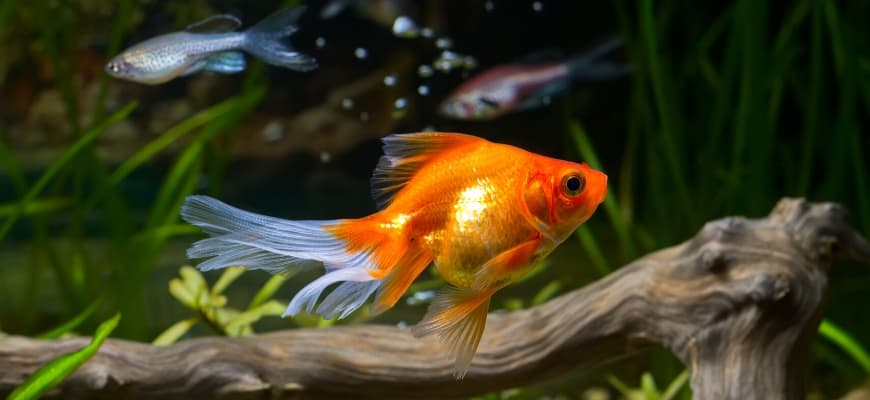
As you can see, goldfish are far more diverse than the equally popular Betta, and this leads to a challenge when creating a comprehensive care guide. Some types thrive in outdoor ponds while other goldfish can live in warm water. Since ponds are a whole separate topic, I’m going to focus on caring for goldfish in aquariums.
Setting Up Your Goldfish Habitat
While single-tailed goldfish, like the Common and Comet, are hearty and easy to accommodate in a variety of tank set-ups, fancy types with telescope eyes and pom poms are more delicate. The specific set-up you’ll need will vary depending on your type of goldfish.
Aquarium Size
Goldfish need plenty of room to swim, eat and explore, and since they can grow from 6 to over 12-inches in length a fishbowl is never appropriate for a goldfish! The size of your tank will depend on which types of fish you’ve decided upon and how many you plan to keep.
While you can certainly start a juvenile goldfish out in a 10-gallon tank, they will outgrow it within months, and being cramped can limit their adult size. To give your goldfish the best start you’ll need at least a 20-gallon long-style tank, and should consider going bigger if you’re keeping more than a single fish.
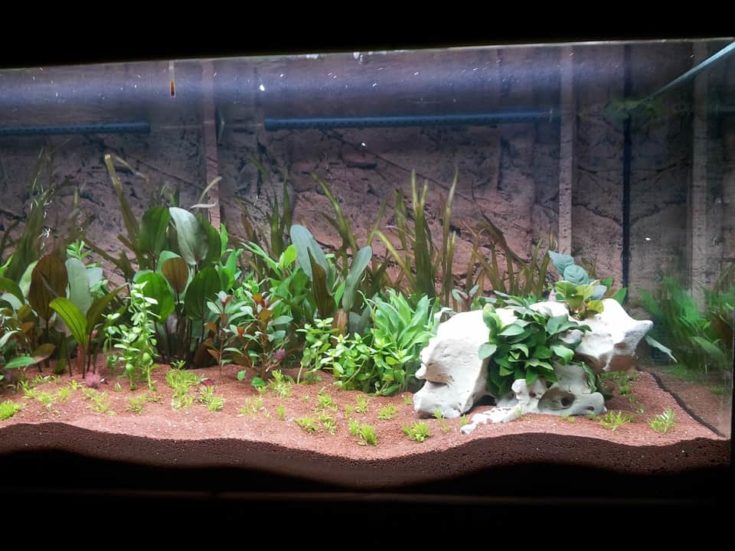
How many gallons per goldfish do you need? It depends, but usually adding 10 to 20 gallons per goldfish gives you enough room for your fish to reach their maximum potential.
Water Quality And Filtration
Let’s talk about your water quality and what kind of conditions you’ll need to have a lively goldfish tank. The most important factors are cleanliness and consistency. Goldfish produce a lot of waste since they are constantly eating, and their tanks often suffer from toxic ammonia spikes. Filtration is a must for goldfish tanks!
You should invest in at least one high-quality 3-stage HOB or canister filtration system for your tank. I’d recommend one that can hold additional ammonia-absorbing filter media. You may need to adjust the filter to provide the minimal current goldfish prefer since they will avoid areas with high flow.
What Kind Of Water Conditions Do Goldfish Need?
- Goldfish are freshwater fish and do well over a wide range of water temperatures and conditions as long as they are stable; fluctuations cause goldfish stress.
- They are not terribly sensitive to water hardness and can adjust to either hard or soft water aquariums.
- They aren’t picky about their pH levels; goldfish do well from pH 6.0 to 8.0.
- They avoid areas with heavy currents and prefer still-to-low water flows.
- Goldfish need very clean, filtered water to remain healthy.
Does Your Goldfish Tank Need A Heater?
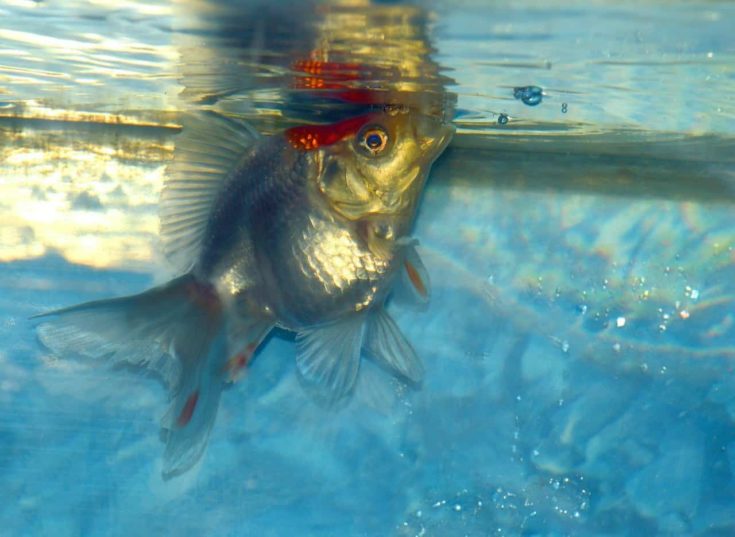
While goldfish can live in warm water over 75°F, many of the hearty single-tail types prefer cooler water and suffer in the warmer temperatures. It may make them lethargic and cause them to stop eating. You may not need a heater for a tank of hearty goldfish if your home’s temperature is stable year-round.
Fancy goldfish almost always do best right around 75°F, and while some can survive lower temperatures it may predispose them to illness and infections. I recommend using a heater to maintain a stable temperature for these delicate goldfish. A sudden drop of a few degrees could be all that’s needed to make your goldfish sick.
Hoods, Lids And Lights
Single tail goldfish can swim very fast and could certainly leap out of your aquarium, so a lid, cover or hood is a good idea. They can be helpful for fancy tanks too, since they slow the rate of water evaporation. For lighting, LED aquarium lights are ideal for goldfish tanks and won’t add any heat to your habitat.
Too much light can boost algae growth, though. I recommend between 8 and 12 hours of light per day maximum. Cut back further if algae becomes a problem, and do several water changes to reduce the nutrient levels in your tank water.
Plants, Decorations And Substrate
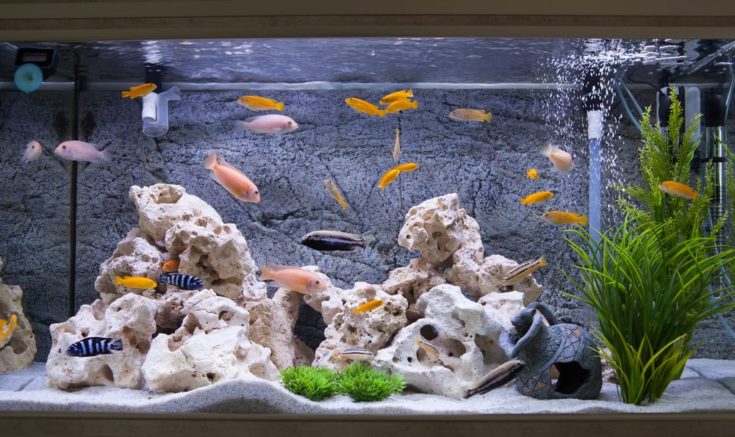
Goldfish love to eat and uproot plants, so I don’t recommend keeping them in planted aquariums. But you can certainly give them some plastic plants and other decorations like rocks, caves and sticks to explore! Leave plenty of open areas for swimming and place the decorations along the back and sides of your tank.
You don’t need to worry much about your decor if you’re keeping single tail goldfish, but for fancy types you may need to take other precautions. Fantail and Veiltail goldfish can hurt their long fins on hard gravel or cut them on your decor. You may be better off using soft aquatic sand or a fine gravel substrate.
Telescopic-eyed goldfish and types with fluid-filled bubbles and pom poms are very delicate and can’t swim very well. You’ll want to avoid using decorations that could poke or puncture their eyes/bubbles/poms. Long, open tanks with fewer plastic plants and rounded decorations are safest.
Goldfish Diet And Feeding In Aquariums
I’ve already mentioned that goldfish have voracious appetites and are always hunting for food. There is a ton of confusion on the internet about what to feed, how often and how much to feed goldfish. It does not have to be this confusing, so let’s lay out some basic rules!
What To Feed Goldfish
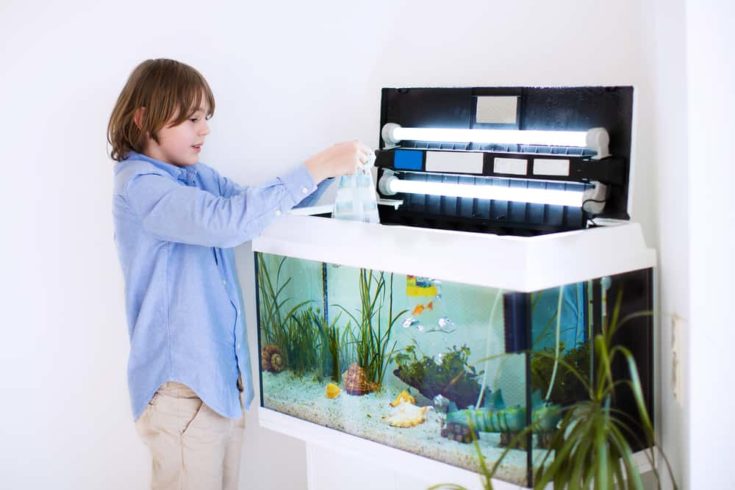
First, most pet goldfish are fed too much, too often and suffer from health problems related to their weight and diet. Fancy goldfish, with their squat, round bodies often have trouble with constipation, especially if they are fed too many treat foods.
- You should pick a well-rounded commercial omnivore flake or floating diet as your primary goldfish food.
- Hearty fast-swimming goldfish can easily eat either, but many of the fancy fish can’t dive for flake foods and often do better with floating pellets.
In terms of treats, I offer my adult goldfish treats once or twice a week. Instead of giving them their usual commercial diet, I substitute it with fresh/frozen/freeze dried:
- Brine shrimp or bloodworms
- Daphnia eggs
- Mosquito larvae
- Sinking vegetable/algae disk (for single-tail goldfish only).
How Often To Feed Adult Goldfish
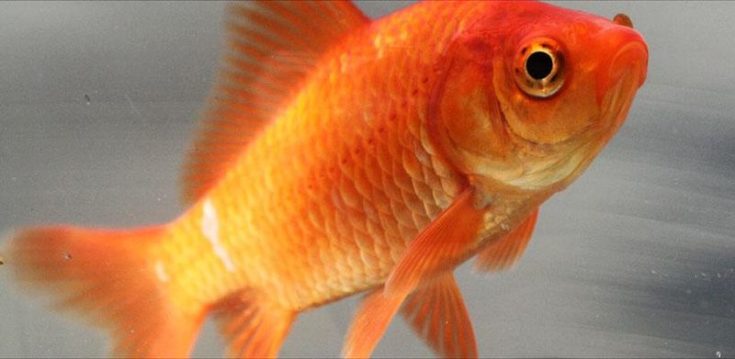
When it comes to frequency, while there are times to offer multiple meals, the typical adult goldfish will do well being fed once every 24-hours. They naturally start looking for food at dawn (and dusk), so I usually feed my goldfish tanks right after their lights switch on. Your fish will anticipate their meals if you’re consistent in your timing!
I also fast my adult fish one day out of every 7, so they only get 6 meals a week. Don’t worry, a regular fast won’t hurt your adults. They’ll just spend the day nibbling any algae in your tank and hunting for food scraps!
How Much To Feed Your Goldfish
It’s really easy to overfeed goldfish, because like Bettas, their stomach is about the size of their eyeball. A single pellet or flake of food can be a full meal for a small goldfish! So limit your meals and treat offerings to a portion the size of their eyeball, which is about all the food they can eat in 1 to 2 minutes, and remove any extras.
When To Alter Your Goldfish Feeding Regimen
There are times when goldfish need frequent meals, and conversely other times when you may need to cut back and fast them several days a week. Baby goldfish, called fry, do best eating 3 meals a day for a few weeks after hatching, and then I switch to twice a day feedings until they are mature. They get more treats, too!
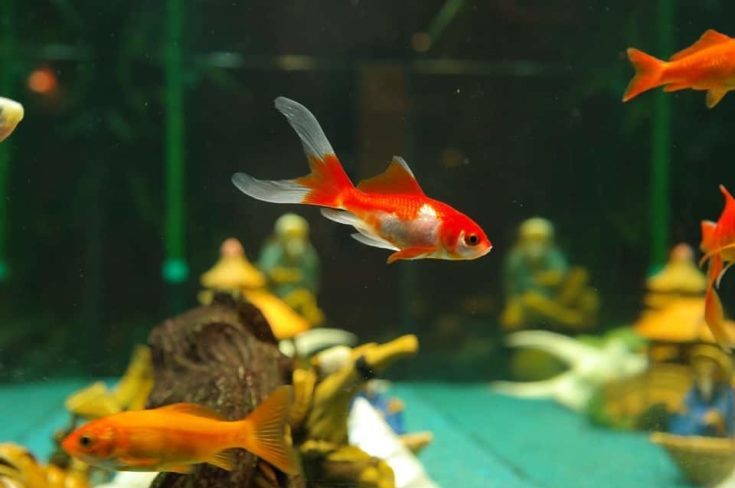
If you want to mimic a period of wintertime hibernation, you could let your tank temperature drop for a few months. The specific temperature varies depending on the type, however. Lower temperatures stimulate your fish to go into a suspended, sleep-like state. When their metabolism drops, they eat less and not as often.
When you raise their tank’s temperature after a period of hibernation, your goldfish may naturally begin to spawn. I talk more about breeding goldfish below, but spawning fish need more food and higher protein levels to produce healthy fry. You’ll want to adjust your feeding regimen as well when breeding your fish.
Alternate Feeding Regimens For Goldfish At Different Life Stages
Goldfish Life Stage
Juvenile Goldfish
Adult Goldfish
Pond or Winter Conditions
Spawning Fish
Meals per Day
2 to 3
1
1 or every other day
2 to 3
Sub Treats for Meals?
2 to 5 meals per week
1 to 2 meals per week
1 meal per week
3 meals per week
Goldfish Life Stage
Juvenile Goldfish
Meals per Day
2 to 3
Sub Treats for Meals?
2 to 5 meals per week
Goldfish Life Stage
Adult Goldfish
Meals per Day
1
Sub Treats for Meals?
1 to 2 meals per week
Goldfish Life Stage
Pond or Winter Conditions
Meals per Day
1 or every other day
Sub Treats for Meals?
1 meal per week
Goldfish Life Stage
Spawning Fish
Meals per Day
2 to 3
Sub Treats for Meals?
3 meals per week
Breeding Goldfish
It’s not always easy to breed goldfish but many fish will spawn on their own if conditions in the tank are right. Your male fish may chase your females in the spring or when their water temperature rises after a cooler period. If your females respond by laying eggs in the corner of your tank, the male will likely fertilize them!
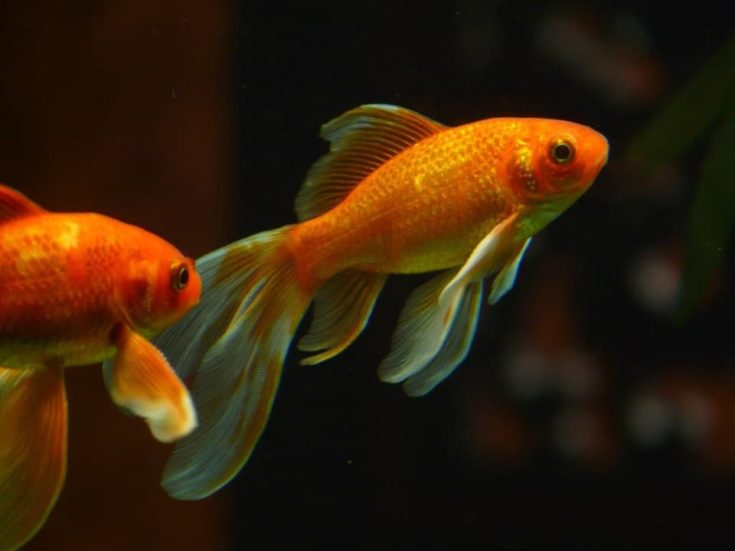
If you want to try your hand at raising the fry, you’ll have to carefully collect the eggs from your main tank and set them up in a separate 20-gallon tank with a heater and fine sponge filter. Otherwise, your goldfish will eat the eggs. The temperature should be the same as your main tank or just a bit higher.
Within 4 to 7 days your fry should hatch, and for the first few days, they’ll just lie around upright on the bottom of their tank. Once they start swimming you can begin to feed them, although they may need a special fine diet for the first couple of weeks.
Maintaining A Goldfish Tank
Goldfish are very messy fish who typically stir up their substrate looking for food. They also uproot live and plastic plants and may move them around. Since they have big appetites and are always eating, they produce a heavy load of biowaste. Even with a top-rated filter, you’ll have to be diligent in doing your water changes.
Keep Up With Your Regular Water Changes
For a 20 to 30-gallon set-up with a 3-stage HOB or canister filtration system, you can probably get by with doing a 10 to 20% water change every week. Be sure to vacuum your gravel well too, to collect any stray fish poop your filter didn’t catch! If your water is really dirty or if you have any sick fish, you can do up to a 50% water change.
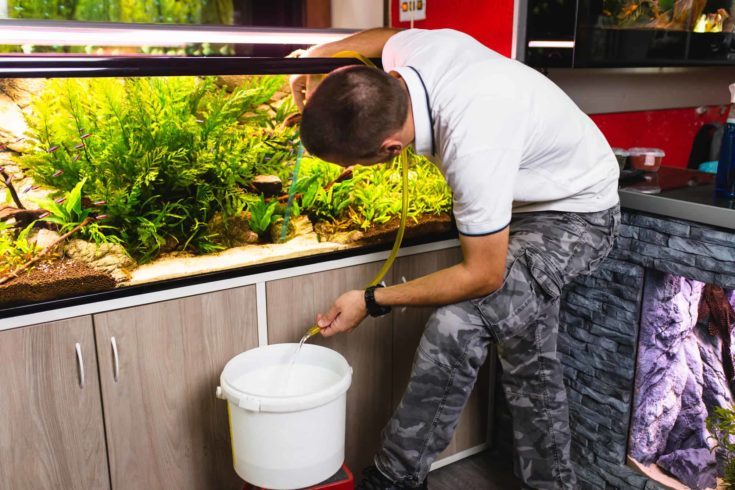
For larger tanks, the frequency of water changes will just depend on the size, number of filtration systems and the capacity of the tank. A 55-gallon tank with two filters and a few goldfish may only need a water change every month, while the same tank with a single filter or more fish may still need it weekly.
Watch For Algae Outbreaks
Since goldfish produce so much waste, it’s very common to have algae outbreaks in their tanks. In an ideal world, you could use live plants to use up those extra nutrients once your good aquatic bacteria had transformed the toxic ammonia into usable nitrates. But it’s very hard to maintain a planted goldfish tank, so this rarely works.
Using fresh carbon and ammonia-absorbing resins in your filters can keep your water cleaner and help prevent the build-up of nutrients that feed algae growth. Having a good algae-eating goldfish tank mate can also help. Regular water changes and reducing the amount of light your tank gets can work to limit algae problems too.
Goldfish Health
If you feed your goldfish a well-balanced diet, properly maintain your tank and filter and keep up on your water changes your fish should enjoy good health and a long life! Still, sometimes a tank crashes from a spike of ammonia or your fish picks up a disease or parasite from a new tank mate.
Here are the signs that your goldfish is stressed or getting sick:
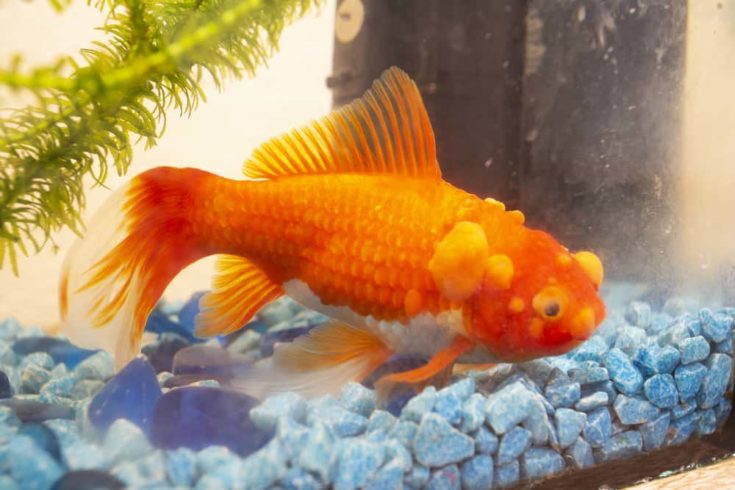
- Reduced appetite or refusal to eat
- Faded or muted color even while awake
- Lethargy or sleeping all the time
- Constant yawning or gasping for air at the surface of the tank
- Inability to swim straight, swimming in circles, floating upside down or sideways
Stress Often Leads To Sickness In Goldfish
If you noticed your fish are stressed, take a look at your tank and see if the problem is obvious. You may be able to adjust your water temperature or alter your filtration system to fix the problem. High ammonia levels are the most common reason for sudden sickness, but you’ll still have to diagnose and possibly medicate your fish.
I’d test the tank’s ammonia level right off and do an immediate 50% water change. You can also consult with your local fish store experts if you suspect a bacterial or fungal infection. Some common goldfish health problems and their treatments are included in the chart below.
Health Issue
Swimming sideways, upside down or inability to swim at all (more common in fancy goldfish)
Symptoms or Causes
Bacterial Infection
Swim Bladder Disease
Suggested Action
Yes; antibiotic medications available
Maybe. Swim Bladder problems can be genetic, complex and not always curable
Health Issue
Constant yawning, gasping at the surface, red or inflamed gills
Symptoms or Causes
Ammonia Poisoning
Suggested Action
Possibly, but immediate attention needed. Test ammonia levels/pH and do a 50% water change. Repeat every 24-hours until symptoms resolve, then establish a regular regimen of testing and water changes
Health Issue
Red ulcerations along with the fins or body
And/or
Ragged edges of fins with red or black coloration
Symptoms or Causes
Injury from tank decor or other fish
High ammonia levels
Bacterial or fungal infection
(Fin/Tail Rot especially)
Suggested Action
Quarantine infected fish, and treat with an antifungal medication.Yes. Fix tank to prevent further injury and treat for any secondary infections
Yes, 50% water change and better routine maintenance
Yes, but likely other underlying problems that also need to be addressed
Health Issue
White or yellow spots on body, head or fins, or patches that look like cotton growing on the fins and/or body
Symptoms or Causes
Sores and ulcers on the body and head, ragged, bloody fins.Bacterial or fungal infection
(Ick, Velvet Disease, CottonMouth, more rarely Head in Hole disease)
Suggested Action
Possibly, depending on the diagnosis. Underlying problems with tank must be addressed too
Health Issue
Body/abdomen looks bloated
Bloat progresses until scales bulge like a pinecone
Symptoms or Causes
Constipation/Early Dropsy
Dropsy
Suggested Action
Water changes and diet adjustment may help
Usually fatal
Health Issue
Fluid build-up behind the eyes which causes them to bulge
Symptoms or Causes
Poor water quality, secondary bacterial or fungal infection
(Popeye)
Suggested Action
Often, but symptoms may not totally fade and may reappear if the tank’s conditions don’t improve
Tips For Starting A Goldfish Tank!
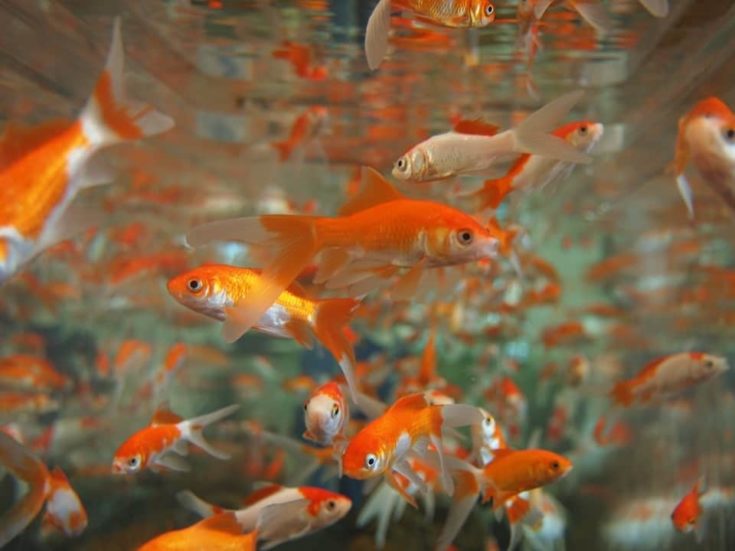
Now it’s time to put everything in this guide together and get your tank started. Before you can pick out any fish you’ll need to set up your tank and allow it to cycle, to give the good bacteria time to establish themselves. In the meantime, you’ll likely want some advice about what other supplies you may find useful!
Cycling Your Goldfish Tank
Once you’ve purchased your tank, filter, decorations and other equipment you’ll have to set everything up before you can top it off with water. Rinse and add your substrate to the bottom, set-up the filter and lights and add your decorations to the tank. Once the water is added, turn on your heater and filter and adjust the settings.
Many sites talk about the nitrogen cycle in goldfish aquariums, but they often miss a key point—You can cycle an empty tank for months and still have no healthy bacteria populations. Cycling alone is not enough; you have to actually add some good bacteria to your tank for it to grow and spread.
You can get the bacteria along with some substrates or add it in a liquid form to your tank (see below). Alternatively, you can take some old substrate or media from an existing tank and place it in your cycling tank to start the process. Many fish stores will give you some of their used substrate or water from a healthy tank for free, too.
When To Add Goldfish To Your Tank
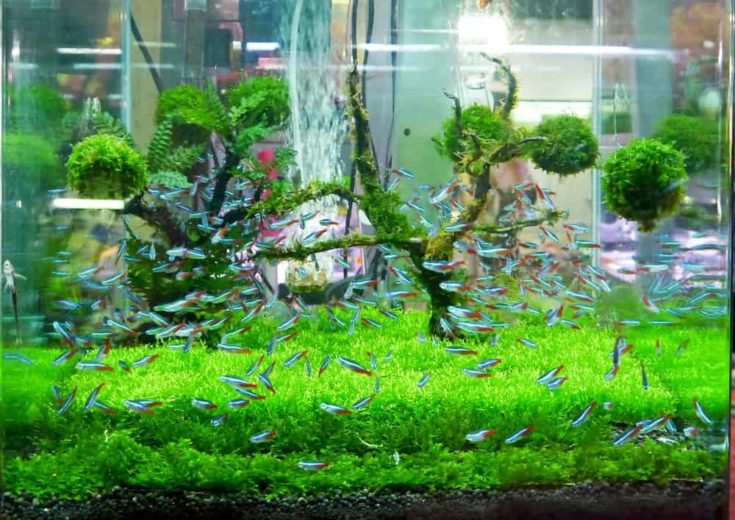
I usually cycle a new tank for about 2 to 3 weeks before adding fish, and then I start with a few small minnows or other inexpensive tropical fish. Testing the ammonia levels every week can help you track how your tank is doing. When the ammonia levels drop to zero, your tank is cycled and ready for some goldfish!
Additional Supplies And Product Recommendations
While you’ve probably focused your attention on buying your aquarium and the associated equipment, there are other supplies that may come in handy once you start caring for your new tank of goldfish.
For your primary feedings, consider these high-quality diets:
- NLS Premium Flake Food with Color Enhancers
- Tetra Floating Goldfish Pellets
A few options for goldfish treats include:
- Omega One Freeze Dried Brine Shrimp
- Aqua Edibles Super Eggs
- Omega One Freeze Dried Bloodworms
- Fluval Bug Bit Granules for Goldfish
To make water changes, maintenance and testing easier, consider the following products:
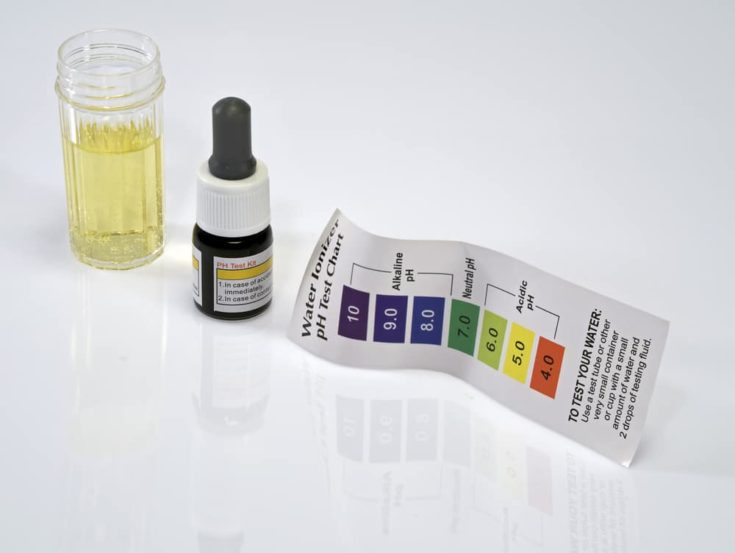
- Python No-Spill Water Changing Hose System
- Fluval Ammonia Removing Filter Media
- Imagitarium Activated Charcoal
- API Freshwater Master Testing Kit
- Seachem Ammonia Alert Accessory
To get a jump-start on establishing the good bacteria it’s easiest to just buy a bottle of liquid bacteria to add to your tank as you cycle it:
- Brightwell Aquatics Liquid Bacteria for Fresh and Marine Tanks
- Imagitarium Biological Booster
Conclusion
Most single-tail and fancy goldfish are easy to care for as long as you keep their water clean. Many problems can be averted if you don’t overfeed your fish and keep up on routine maintenance.
If you’ve enjoyed this comprehensive guide to all things goldfish, I’d love to hear your thoughts and feedback! Did you find the information helpful, and are there any questions we neglected to answer? Post your comments below or follow us on social media. Tell us all about your goldfish aquarium!
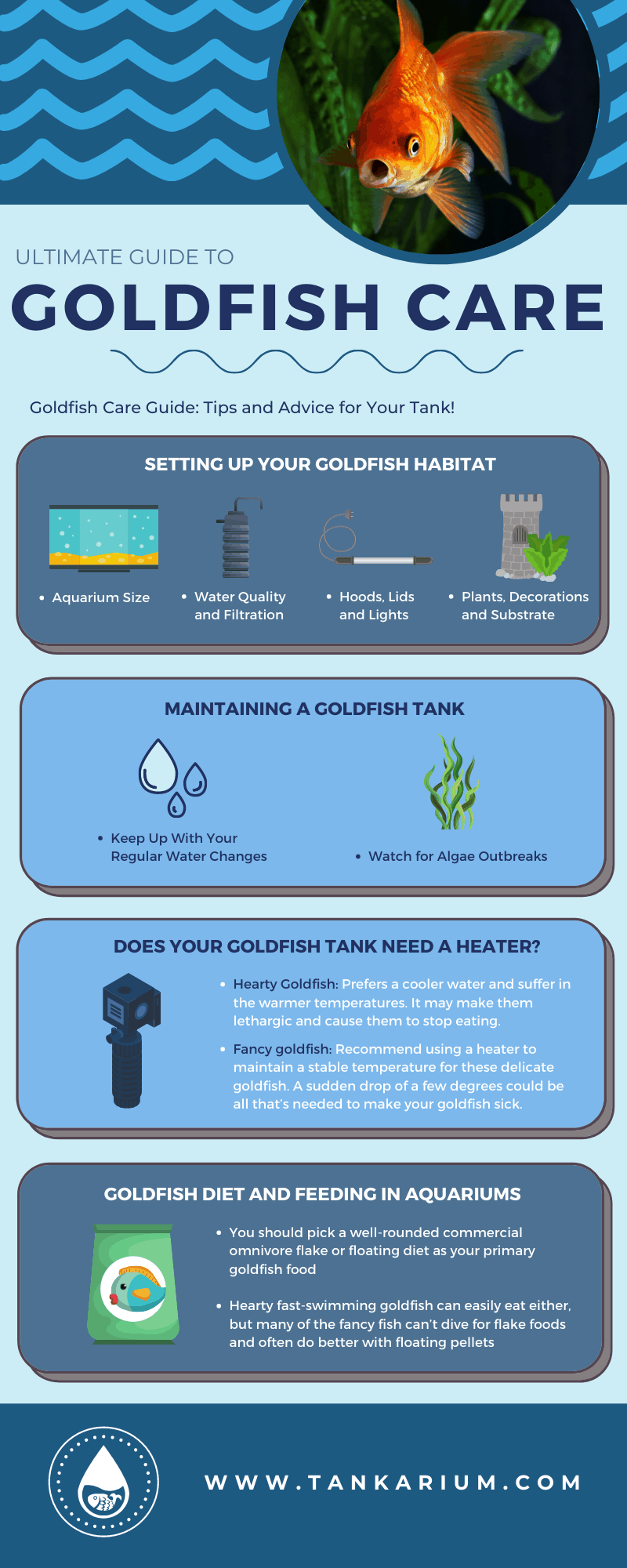

STARTED RESEARCHING TO REPLACE THE FILTER ON A 25 GALLON TANK AND SPENT THE AFTERNOON READING AND LEARNED MORE ABOUT GOLDFISH THEN I KNEW WAS AVAILABLE. I STARTED OUT WITH 5 LITTLE GOLDFISH BUT WENT OUT OF TOWN AND RETURNED TO A MILKY WATERED TANK AND ONE SURVIVOR. THAT WAS 5 YEARS AGO ‘CLEO’ HAS THRIVED AND GROW TO 10 INCHES. I HAVE AN OVER THE BACK FILTER AND IT NEEDS TO BE REPLACED WHICH ENDED ME ON YOUR SITE. VERY INFORMATIVE AND UNDERSTANDABLE.
THANK YOU
I’m a new goldfish owner and this was a very good guide. I learned much that I wish I had known before I brought my fish home.
Thanks.